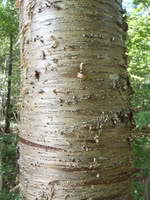Mon-Fri 9am - 5pm Mountain time
Black Locust vs Yellow Birch
Robinia pseudoacacia
Betula alleghaniensis
NOT AVAILABLE THIS SEASON - MIGHT RETURN
Black Locust is an attractive tree. Its distinctive leaves are made of about a dozen bright green leaflets. It also notable for its fragrant white flowers, which smell of citrus.
Black Locust can grow in many situations, but prefers dry areas with lots of sun. It is robust and is an excellent choice for establishing shade in dry, open areas.
Important note: Much of the Black Locust is toxic to humans and livestock, including seeds, bark, and leaves.
Yellow Birch is a large and valuable hardwood species in northeastern North America. The bark on its limbs and young trunks is silvery-yellowish in colour, hence the name. This tree prefers to grow in cool regions with damp or saturated soil.
Yellow Birch can be tapped for syrup, like Sugar Maple. Although the sap has less sugar content, it flows in greater quantity than maple trees.
Note: Unfortunately this difficult to grow species is not currently scheduled to grow at TreeTime.ca. Perhaps try purchasing seed from SeedTime.ca and growing your own? Or sign up for a restock notification above.

